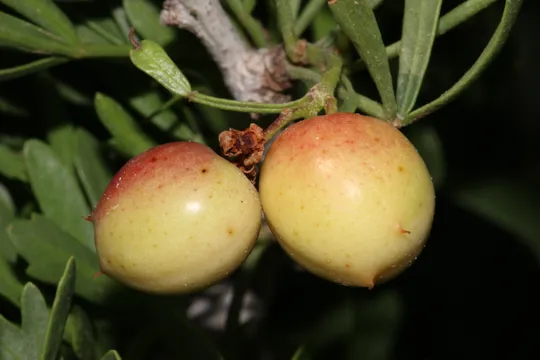Tizra Tree
Searsia pentaphylla






Rhus pentaphylla is a thorny shrub up to one meter high that sheds its leaves in winter and in summer. The smooth leaves are palmate and have five lobes, up to five cm in diameter; main and lateral branches are thorny. Leaflets are elongated to lance-shaped, entire or lobed. The plant is bi-sexual, with minute, monosexual flowers arranged in small inflorescences. The calyx has five oval lobes and it is a quarter of the corolla length. The flower has five yellow, oval petals, 2 mm long and is probably pollinated by small insects (flies and bees) or by wind. Pollination restrictions and low fruitset may be caused by the small population of this species. The red fruit is round and smooth, 1 cm across and has three bulges at its end.
Tannin, which is used for tanning leather in North Africa, is produced from its roots and wood.
Very rare in Israel, it grows only in a single site in the Acre Valley, in Rosh HaNikra on the escarpment facing the sea.
On soft limestone facing the sea.
Rhus pentaphylla is a vicarious species of Rhus tripartita. Both species grow in very similar habitats, and have a similar thorny appearance and flowers. They differ mainly in the number of leaflets – 3 in Rhus tripartita and 5 in Rhus pentaphylla (hence its name), but in the Rosh HaNikra population there are shrubs whose leaves have three leaflets. Rhus tripartita is a Mediterranean-desert ecotone species. It is common in eastern Samaria, in the Judean Desert western Samaria and in an interesting patch near Rosh HaAyin.
• The population is located near a popular tourist site, and is in constant danger from development work and pollution. The site is on a very steep slope, 20 meters below the road about 100 yards from a tourist cable car. Debris and trash are often discarded on the site, and there is a real danger that the earthworks or construction will inadvertently harm the plants and lead to the loss of the only Rhus pentaphylla location in Israel and in the entire Eastern Mediterranean basin.
• Its small population size may lead to pollination problems.
• The species grows on a single site, separated by thousands of kilometers from the sites on the coast of Tunis or in Sicily! The Rosh HaNikra site is the only place known in the entire Eastern Mediterranean.
• There is no precise information regarding population size, which is roughly estimated at 5-30 individuals. In 1993, only five specimens were counted.
• The species is found in the Maghreb region, but there is no information about how development affects its populations.
• It is not protected in a reserve.
1. The Rosh HaNikra population should be monitored regularly every six months.
2. Efforts should be made to have the site declared a protected area. 3. Waste disposal or leakage of toxins and subterranean dissolved compounds from the road to the site should be prevented.
: A Western Mediterranean shrub that grows only in the southern section of the Western Mediterranean Basin. Grows on rocky beaches of Morocco, Algeria, Sicily and Tunis. In the Maghreb countries it is found in the sub-forests of the Tetraclinis articulate, a coniferous tree similar to the cypress, that grow in the plains and low hills near the coast. It is not found on the coasts of Cyprus, Lebanon, Turkey, Egypt and Libya. The Rosh HaNikra site is the only one in the Eastern Mediterranean basin.
One of the rarest plants in the country, with a very small number of individuals. Despite being a shrub, it is not yet included in the list of protected plants. It grows on a single site in Rosh HaNikra, where it is under constant threat. The site is not part of a nature reserve. This site in Israel is the only site in the eastern Mediterranean. This is one of the most important plants in Israel for preservation, and it is important to protect its habitat.
אתר האינטרנט של WWF:
http://www.worldwildlife.org/wildworld/profiles/terrestrial/pa/pa1214_full.html#threats
Current Occupancy Map
| 1000 squre meter pixel | 5000 squre meter pixel | 10000 squre meter pixel | |
|---|---|---|---|
| number of observations | 0 | 0 | 0 |
| in total pixels | 0 | 0 | 0 |
| Family | Anacardiaceae |
| Classification | On the endangered species list |
| Ecosystem | Mediterranean |
| Chorotype | Mediterranean |
| Conservation Site | Rosh HaNikra coastal area |
| Rarity |
1
6
6
|
|---|---|
| Vulnerability |
0
3
4
|
| Attractiveness |
0
0
4
|
| Endemism |
0
0
4
|
| Red number |
1
5.3
10
|
| Peripherality | W |
| IUCN category | DD EW EX LC CR EN VU NT |
| Threat Definition according to the red book | Critically endangered |
 Based on:
Based on:






